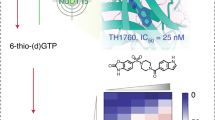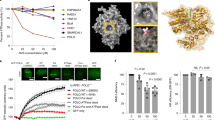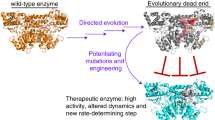Abstract
Bacterial- and yeast- encoded cytosine deaminases (bCD and yCD, respectively) are widely investigated suicide enzymes used in combination with the prodrug 5-fluorocytosine (5FC) to achieve localized cytotoxicity. Yet characteristics such as poor turnover rates of 5FC (bCD) and enzyme thermolability (yCD) preclude their full therapeutic potential. We previously applied regio-specific random mutagenesis and computational design to create novel bCD and yCD variants with altered substrate preference (bCD1525) or increased thermostability (yCDdouble, yCDtriple) to aid in overcoming these limitations. Others have utilized pathway engineering in which the microbial enzyme uracil phosphoribosyltransferase (UPRT) is fused with its respective CD, creating bCD/bUPRT or yCD/yUPRT. In this study, we evaluated whether the overlay of CD mutants onto their respective CD/UPRT fusion construct would further enhance 5FC activation, cancer cell prodrug sensitivity and bystander activity in vitro and in vivo. We show that all mutant fusion enzymes allowed for significant reductions in IC50 values relative to their mutant CD counterparts. However, in vivo the CD mutants displayed enhanced tumor growth inhibition capacity relative to the mutant fusions, with bCD1525 displaying the greatest tumor growth inhibition and bystander activity. In summary, mutant bCD1525 appears to be the most effective of all bacterial or yeast CD or CD/UPRT enzymes examined and as such is likely to be the best choice to significantly improve the clinical outcome of CD/5FC suicide gene therapy applications.
This is a preview of subscription content, access via your institution
Access options
Subscribe to this journal
Receive 12 print issues and online access
$259.00 per year
only $21.58 per issue
Buy this article
- Purchase on Springer Link
- Instant access to full article PDF
Prices may be subject to local taxes which are calculated during checkout




Similar content being viewed by others
References
Olga G, Gabi UD . Gene directed enzyme/prodrug therapy of cancer: historical appraisal and future prospectives. J Cell Physiol 2001; 187: 22–36.
Longley DB, Harkin DP, Johnston PG . 5-Fluorouracil: mechanisms of action and clinical strategies. Nat Rev Cancer 2003; 3: 330–338.
Huber BE, Austin EA, Richards CA, Davis ST, Good SS . Metabolism of 5-fluorocytosine to 5-fluorouracil in human colorectal tumor cells transduced with the cytosine deaminase gene: significant antitumor effects when only a small percentage of tumor cells express cytosine deaminase. Proc Natl Acad Sci USA 1994; 91: 8302–8306.
Mullen CA, Coale MM, Lowe R, Blaese RM . Tumors expressing the cytosine deaminase suicide gene can be eliminated in vivo with 5-fluorocytosine and induce protective immunity to wild type tumor. Cancer Res 1994; 54: 1503–1506.
Austin EA, Huber BE . A first step in the development of gene therapy for colorectal carcinoma: cloning, sequencing, and expression of Escherichia coli cytosine deaminase. Mol Pharmacol 1993; 43: 380–387.
Kievit E, Bershad E, Ng E, Sethna P, Dev I, Lawrence TS et al. Superiority of yeast over bacterial cytosine deaminase for enzyme/prodrug gene therapy in colon cancer xenografts. Cancer Res 1999; 59: 1417–1421.
Kievit E, Nyati MK, Ng E, Stegman LD, Parsels J, Ross BD et al. Yeast cytosine deaminase improves radiosensitization and bystander effect by 5-fluorocytosine of human colorectal cancer xenografts. Cancer Res 2000; 60: 6649–6655.
Korkegian A, Black ME, Baker D, Stoddard BL . Computational thermostabilization of an enzyme. Science 2005; 308: 857–860.
Stolworthy TS, Korkegian AM, Willmon CL, Ardiani A, Cundiff J, Stoddard BL et al. Yeast cytosine deaminase mutants with increased thermostability impart sensitivity to 5-fluorocytosine. J Mol Biol 2008; 377: 854–869.
Fuchita M, Ardiani A, Zhao L, Serve K, Stoddard BL, Black ME . Bacterial cytosine deaminase mutants created by molecular engineering show improved 5-fluorocytosine-mediated cell killing in vitro and in vivo. Cancer Res 2009; 69: 4791–4799.
Lundegaard C, Jensen KF . Kinetic mechanism of uracil phosphoribosyltransferase from Escherichia coli and catalytic importance of the conserved proline in the PRPP binding site. Biochemistry 1999; 38: 3327–3334.
Kern L, de Montigny J, Jund R, Lacroute F . The FUR1 gene of Saccharomyces cerevisiae: cloning, structure and expression of wild-type and mutant alleles. Gene 1990; 88: 149–157.
Kanai F, Kawakami T, Hamada H, Sadata A, Yoshida Y, Tanaka T et al. Adenovirus-mediated transduction of Escherichia coli uracil phosphoribosyltransferase gene sensitizes cancer cells to low concentrations of 5-fluorouracil. Cancer Res 1998; 58: 1946–1951.
Vauthey JN, de Marsh R, Cendan JC, Chu NM, Copeland EM . Arterial therapy of hepatic colorectal metastases. Br J Surgery 1996; 83: 447–455.
Harris JD, Gutierrez AA, Hurst HC, Sikora K, Lemoine NR . Gene therapy for cancer using tumour-specific prodrug activation. Gene Ther 1994; 1: 170–175.
Tiraby M, Cazaux C, Baron M, Drocourt D, Reynes J-P, Tiraby G . Concomitant expression of E. coli cytosine deaminase and uracil phosphoribosyltransferase improves the cytotoxicity of 5-fluorocytosine. FEMS Microbiol Lett 1998; 167: 41–49.
Erbs P, Regulier E, Kintz J, Leroy P, Poitevin Y, Exinger F et al. In vivo cancer gene therapy by adenovirus-mediated transfer of a bifunctional yeast cytosine deaminase/uracil phosphoribosyltransferase fusion gene. Cancer Res 2000; 60: 3813–3822.
Xing L, Sun X, Deng X, Kotedia K, Urano M, Koutcher JA et al. Expression of the bifunctional suicide gene CDUPRT increases radiosensitization and bystander effect of 5-FC in prostate cancer cells. Radiother Oncol 2009; 92: 345–352.
Gopinath P, Ghosh S . Apoptotic induction with bifunctional E. coli cytosine deaminase-uracil phosphoribosyltransferase mediated suicide gene therapy is synergized by curcumin treatment in vitro. Mol Biotechnol 2008; 39: 39–48.
Koyama F, Sawada H, Hirao T, Fujii H, Hamada H, Nakano H . Combined suicide gene therapy for human colon cancer cells using adenovirus-mediated transfer of Escherichia coli cytosine deaminase gene and Escherichia coli uracil phosphoribosyltransferase gene with 5-fluorocytosine. Cancer Gene Ther 2000; 7: 1015.
Andersen PS, Smith JM, Mygind B . Characterization of the upp gene encoding uracil phosphoribosyltransferase of Escherichia coli K12. Eur J Biochem 1992; 204: 51–56.
Arsene-Ploetze F, Nicoloff H, Kammerer B, Martinussen J, Bringel F . Uracil salvage pathway in Lactobacillus plantarum: transcription and genetic studies. J Bacteriol 2006; 188: 4777–4786.
Brady WA, Kokoris MS, Fitzgibbon M, Black ME . Cloning, characterization, and modeling of mouse and human guanylate kinases. J Biol Chem 1996; 271: 16734–16740.
Mahan SD, Ireton GC, Stoddard BL, Black ME . Alanine-scanning mutagenesis reveals a cytosine deaminase mutant with altered substrate preference. Biochemistry 2004; 43: 8957–8964.
Mahan SD, Ireton GC, Knoeber C, Stoddard BL, Black ME . Random mutagenesis and selection of Escherichia coli cytosine deaminase for cancer gene therapy. Protein Eng Des Sel 2004; 17: 625–633.
Kuriyama S, Masui K, Sakamoto T, Nakatani T, Kikukawa M, Tsujinoue H et al. Bystander effect caused by cytosine deaminase gene and 5-fluorocytosine in vitro is substantially mediated by generated 5-fluorouracil. Anticancer Res 1998; 18: 3399–3406.
Lawrence TS, Rehemtulla A, Ng EY, Wilson M, Trosko JE, Stetson PL . Preferential cytotoxicity of cells transduced with cytosine deaminase compared to bystander cells after treatment with 5-flucytosine. Cancer Res 1998; 58: 2588–2593.
Franken NAP, Rodermond HM, Stap J, Haveman J, van Bree C . Clonogenic assay of cells in vitro. Nat Protoc 2006; 1: 2315–2319.
Graepler F, Lemken M-L, Wybranietz WA, Schmidt U, Smirnow I, Gross CD et al. Bifunctional chimeric SuperCD suicide gene - YCD:YUPRT fusion is highly effective in a rat hepatoma model. World J Gastoenterol 2005; 11: 6910–6919.
Chung-Faye GA, Chen MJ, Green NK, Burton A, Anderson D, Mautner V et al. In vivo gene therapy for colon cancer using adenovirus-mediated transfer of the fusion gene cytosine deaminase and uracil phosphoribosyltransferase. Gene Ther 2001; 8: 1547–1554.
Bourbeau D, Lavoie G, Nalbantoglu J, Massie B . Suicide gene therapy with an adenovirus expressing the fusion gene CD∷UPRT in human glioblastomas: different sensitivities correlate with p53 status. J Gene Med 2004; 6: 1320–1332.
Pandha HS, Martin L-A, Rigg A, Hurst HC, Stamp GW, Sikora K et al. Genetic prodrug activation therapy for breast cancer: a phase I clinical trial of erbB-2-directed suicide gene expression. J Clin Oncol 1999; 17: 2180–2189.
Crystal RG, Hirschowitz E, Lieberman M, Daly J, Kazam E, Henschke C et al. Phase I study of direct administration of a replication deficient adenovirus vector containing the E. coli cytosine deaminase gene to metastatic colon carcinoma of the liver in association with the oral administration of the pro-drug 5-fluorocytosine. Hum Gene Ther 1997; 8: 985–1001.
Freytag SO, Stricker H, Pegg J, Paielli D, Pradhan DG, Peabody J et al. Phase I study of replication-competent adenovirus-mediated double-suicide gene therapy in combination with conventional-dose three-dimensional conformal radiation therapy for the treatment of newly diagnosed, intermediate to high-risk prostate cancer. Cancer Res 2003; 63: 7497–7506.
Park JI, Cao L, Platt VM, Huang Z, Stull RA, Dy EE et al. Antitumor therapy mediated by 5-fluorocytosine and a recombinant fusion protein containing TSG-6 hyaluronan binding domain and yeast cytosine deaminase. Mol Pharm 2009; 6: 801–812.
Senter PD, Su PC, Katsuragi T, Sakai T, Cosand WL, Hellström I et al. Generation of 5-fluorouracil from 5-fluorocytosine by monoclonal antibody-cytosine deaminase conjugates. Bioconjug Chem 1991; 2: 447–451.
Khil MS, Kim JH, Mullen CA, Kim SH, Freytag SO . Radiosensitization by 5-fluorocytosine of human colorectal carcinoma cells in culture transduced with cytosine deaminase gene. Clin Cancer Res 1996; 2: 53–57.
Khatri A, Husaini Y, Ow K, Chapman J, Russell PJ . Cytosine deaminase-uracil phosphoribosyltransferase and interleukin (IL)-12 and IL-18: a multimodal anticancer interface marked by specific modulation in serum cytokines. Clin Cancer Res 2009; 15: 2323–2334.
Ito S, Natsume A, Shimato S, Ohno M, Kato T, Chansakul P et al. Human neural stem cells transduced with IFN-β and cytosine deaminase genes intensify bystander effect in experimental glioma. Cancer Gene Ther 2010; 17: 299–306.
Foloppe J, Kintz J, Futin N, Findeli A, Cordier P, Schlesinger Y et al. Targeted delivery of a suicide gene to human colorectal tumors by a conditionally replicating vaccinia virus. Gene Ther 2008; 15: 1361–1371.
Acknowledgements
This work was supported by the National Institutes of Health through grants R01CA85939 (ME Black) and T32GM008336 (AJ Johnson).
Author information
Authors and Affiliations
Corresponding author
Ethics declarations
Competing interests
The authors declare no conflict of interest.
Rights and permissions
About this article
Cite this article
Johnson, A., Ardiani, A., Sanchez-Bonilla, M. et al. Comparative analysis of enzyme and pathway engineering strategies for 5FC-mediated suicide gene therapy applications. Cancer Gene Ther 18, 533–542 (2011). https://doi.org/10.1038/cgt.2011.6
Received:
Revised:
Accepted:
Published:
Issue Date:
DOI: https://doi.org/10.1038/cgt.2011.6
Keywords
This article is cited by
-
Aspergillus Niger thermostable Cytosine deaminase-dextran conjugates with enhanced structure stability, proteolytic resistance, and Antiproliferative activity
BMC Microbiology (2023)
-
Enzyme/Prodrug Systems for Cancer Gene Therapy
Current Pharmacology Reports (2016)
-
Adenoviral-mediated imaging of gene transfer using a somatostatin receptor-cytosine deaminase fusion protein
Cancer Gene Therapy (2015)
-
Increased sensitivity of glioma cells to 5-fluorocytosine following photo-chemical internalization enhanced nonviral transfection of the cytosine deaminase suicide gene
Journal of Neuro-Oncology (2014)
-
Chemovirotherapy of Malignant Melanoma with a Targeted and Armed Oncolytic Measles Virus
Journal of Investigative Dermatology (2013)



